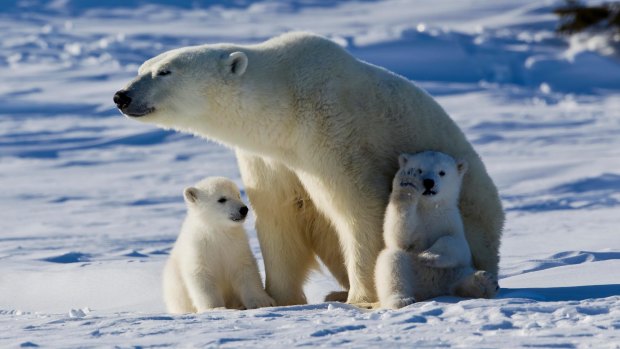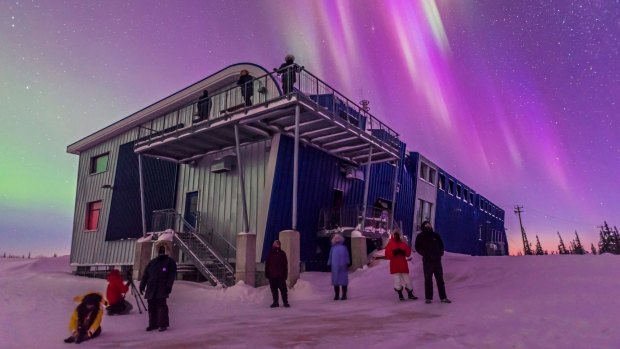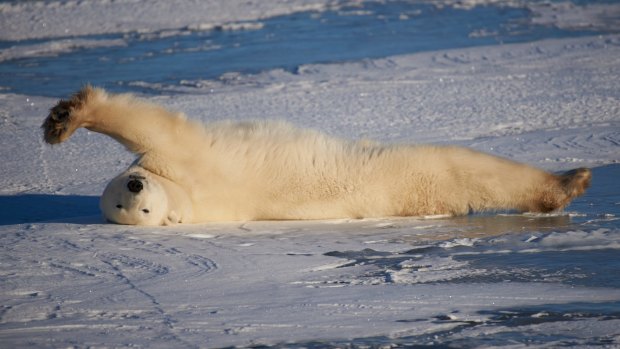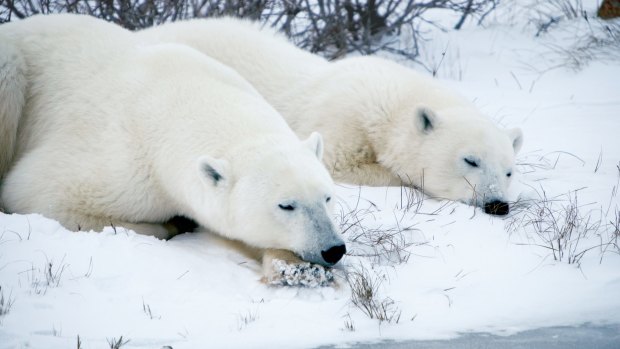This was published 5 years ago
Churchill, Manitoba, Canada: What it's like to visit the 'polar bear capital of the world'
By Julie Miller

Churchill, Manitoba, the polar bear capital of the world.Credit: Alamy
A beautiful blonde in luscious white fur has arrived early at the party. She's not interested in socialising and retreats to the shadows. She's peckish, but the buffet hasn't yet started; instead, she rests, conserving her energy and avoiding the focus of lurking paparazzi.
Meanwhile, a rambunctious teen is also an early contender; but rather than waiting patiently, he wanders off, opportunistically snacking to ease his hunger. But his judgement is poor; infringing others' personal space, he's labelled a "nuisance" and hauled off by armed guards to a holding facility, where he's isolated until the banquet begins in earnest.
Such is the drama that unfolds every October in the Canadian town of Churchill, located in northern Manitoba on the edge of Hudson Bay. Known as the "polar bear capital of the world", this is where the southernmost population of polar bears congregates as they wait on land – sometimes too close for human comfort – for the formation of sea ice and subsequent access to their preferred prey, ringed seals.

RGB_ sunnov4canada Churchill Manitoba Canada polar bears ; text by Julie Miller Destination Canada SUPPLIED https://www.brandcanadalibrary.ca Churchill, northern Manitoba
The presence of the bears during the autumn "freeze-up" presents both opportunities and challenges for Churchill's 800 human residents. The Western Hudson Bay bears (also numbering about 800) are the most studied and handled polar bears on the planet, with human/bear conflict a real part of the equation. But on the flip side, accessibility and sheer numbers result in amazing wildlife viewing opportunities, with tourism a natural by-product of the waiting game.
"Polar bear season" has just begun during my visit to Churchill; and rather than staying at one of the exclusive lodges offering bear-viewing experiences, I am spending four days at the Churchill Northern Studies Centre (CNSC), a not-for-profit facility focusing on sustainability and research into Canada's tundra ecosystem.
As well as providing accommodation, lab facilities and logistical support for scientists in the field, the Centre also offers a range of Learning Vacations, week-long programs aimed at developing a deeper understanding of the environment, led by professional scientists and expert guides.

Tourists enjoy the start of a fine display of Northern Lights at the Churchill Northern Studies.Credit: Alamy
The courses are seasonal: during summer, for instance, there are vacations based around the ecology of beluga whales (with thousands gathering in Churchill River to give birth after the sea ice breaks up); while in spring, there are weeks dedicated to both wildflower enthusiasts and birders.
In winter, skies free of light pollution and an enviable location under the aurora oval distinguishes Churchill as one of the premiere locations to view Northern Lights, with CNSC an ideal base to marvel at this incredible phenomenon.
But it's Churchill's polar bears that are the main attraction, with CNSC's Lords of the Arctic: The Ecology of Hudson Bay's Polar Bears its most popular Learning Vacation. As well as enjoying presentations and tours to observe bears in their natural habitat, participants have the opportunity to work alongside scientists, collecting data as part of a long-term study into the effects of global warming on these magnificent predators, the unwitting poster children for climate change.

'Look a polar bear in the eye, and it will change your life'.
As a research facility, glamour is not on the agenda at CNSC: accommodation is practical and welcoming rather than luxurious. Sleeping quarters consist of 21 dorms, each fitted with two double bunks; while shared bathrooms feature low-flow showers and composting toilets. Meanwhile, at a communal cafeteria, guests dine alongside researchers, who are always keen to share field experiences with curious visitors.
The building itself – located 23 kilometres from town on a former rocket range – is LEEDS-certified and "green", utilising natural materials and lighting, and tripled-paned to retain heat in sub-Arctic conditions. A floating deck provides bear-safe outdoor viewing of night skies; while the heated observatory dome allows 180-degree vistas of the dancing Aurora Borealis without risk of frostbite.
In the depths of winter, temperatures on the tundra plummet to a bone-chilling -45°C; and even in the clemency of autumn, a wind-chill of -15° requires layers unheard of in a standard Australian wardrobe. Fortunately, CNSC rents heavy-duty polar clothing – fur-trimmed Canada Goose parkas, ski pants and après boots – for $15 a day; and while I feel like the Michelin Man as I trudge through ice and mud, at least I am warm.

Sleeping polar bears in Churchill, northern Manitoba.
There's also one rule CNSC strictly enforces: never go outside without an armed guard. The possibility of a polar bear walking past, hiding behind a rock – even wandering down the main street of Churchill – is very real; and while hunting of polar bears is banned in Manitoba, protection against an attacking carnivore is vital.
"Safety-wise, we haven't had a bear-related fatality in Churchill since the early 1980s," CNSC's scientific coordinator, LeeAnn Fishback, tells us during an evening presentation on polar bears and their controversial management in Churchill.
"Bear awareness, education, helping people to secure garbage, and showing people how to behave around bears have all helped. The Polar Bear Alert team's number one goal is to keep people safe; the aim is to reduce mortalities, human and bear."
The most polarising aspect of Churchill's bear management system is its Polar Bear Holding Facility – casually referred to as the "polar bear jail". Bears that habitually wander too close to town are captured and interred here for up to 30 days, before being relocated further north.
"The facility is really about isolating those bears that have learned behaviour that brings them in direct contact with people," Fishback says. "For instance, if a bear breaks into a cabin and takes food, it's rewarded; if they are in the holding facility, they can't do that."
Isolating bears in this manner is a contentious issue; and it seems everyone in Churchill has an opinion about its effectiveness, with the conversation often extremely heated.
"Since it was built in 1982, 2600 bears have been held here – bears that would otherwise have been shot," CNSC's program coordinator Evan Roberts says during a tour of Churchill's provocative street art – including a spectacular image of a sleeping bear adorning the Polar Bear Holding Facility. "Is it perfect? No. Is it better than killing them? I think so."
"Because we're the polar bear capital of the world, we have to be at the forefront of the conversation [about polar bear management]," Roberts continues. "We know more about this population of polar bears than any other; they are the most talked about, researched and handled bears; also the most politicised. This is a lengthy conversation, and people fall hard on either side of the fence."
Polar bear tourism is also an essential part of that discussion, with suggestions that wildlife-loving tourists may be contributing to the decimation of the species, simply by being too close and de-sensitising them to humans.
"There's an argument if the polar bears become conditioned to people, they are more likely to be harvested up north [by the Inuit, who retain hunting rights in the neighbouring state of Nunavut]," Evan says. "But on the other side of the coin, tourism has a massive educational impact – seeing polar bears in the wild really changes your perspective."
On my final day in Churchill, I finally get to experience that for myself during a tundra buggy tour with Frontiers North Adventures. A young female polar bear is asleep behind bushes when we approach; she barely raises her head from a rock cushion, unfazed by the presence of the giant vehicle and its camera-wielding inhabitants.
We sit quietly, observing her, for maybe half an hour; but it soon becomes clear she has no intention of moving. But just as our tour guide Jim kicks the engine over, she turns, looking directly at me.
"Stop, stop!" I shout, camera clicking furiously. I gasp, astounded by her beauty and majesty. Then, bored queen that she is, she turns with a disdainful flick of the head and resumes her slumber.
"Look a polar bear in the eye, and it will change your life," Jim later tells me. I concur.
TRIP NOTES
The writer was a guest of Manitoba Tourism and Churchill Northern Studies Centre.
FLY
Air Canada flies from Sydney to Vancouver daily, and four flights weekly from Melbourne, with domestic connections to Winnipeg. See aircanada.com/au From Winnipeg, flights to Churchill are operated by Calm Air. See calmair.com
STAY
Churchill Northern Studies Centre's Lords of the Arctic Learning Vacations cost $CA3515 per person (quadruple occupancy), including all meals and tours. See churchillscience.ca
FIVE OTHER THINGS TO DO IN CHURCHILL
WATCH THE NORTHERN LIGHTS
Located directly under the aurora halo, Churchill is one of the best places to experience the Northern Lights, with activity occurring on more than 300 nights a year. Magical, mystical, mesmerising.
SPOT WILDLIFE FROM THE AIR
A chopper tour with Hudson Bay Helicopters takes you over the tundra and boreal forest, where polar bears lounge waiting for the sea ice to form. You're also likely to spot moose and even beluga in the mouth of the Churchill River. See hudsonbayheli.com
GO DOG SLEDDING
Dave Daley's huskies love to run; and whether pulling a sled over snow, or a wheeled cart in the summer, the enthusiasm of these dogs is contagious, and loads of fun for passengers. See wapuskadventures.com
VISIT ITSANITAQ MUSEUM
Itsanitaq is an Inuit word meaning "things from the past"; and this delightful collection of indigenous artefacts, first started by Catholic missionaries, showcases the stories and struggles of Canada's northern people.
WALK THE TUNDRA
Paul Ratson's walking tours of Hudson Bay's foreshore provide an intimate view of the tundra eco-system – from delicate, naturally-bonsaied azaleas, orchids and willows, to often ignored wildlife such as Arctic hare and ptarmigan, a fluffy-footed grouse. See nature1sttours.ca
Note: All of these activities are included in CNSC's Lords of the Arctic program.
Sign up for the Traveller Deals newsletter
Get exclusive travel deals delivered straight to your inbox. Sign up now.